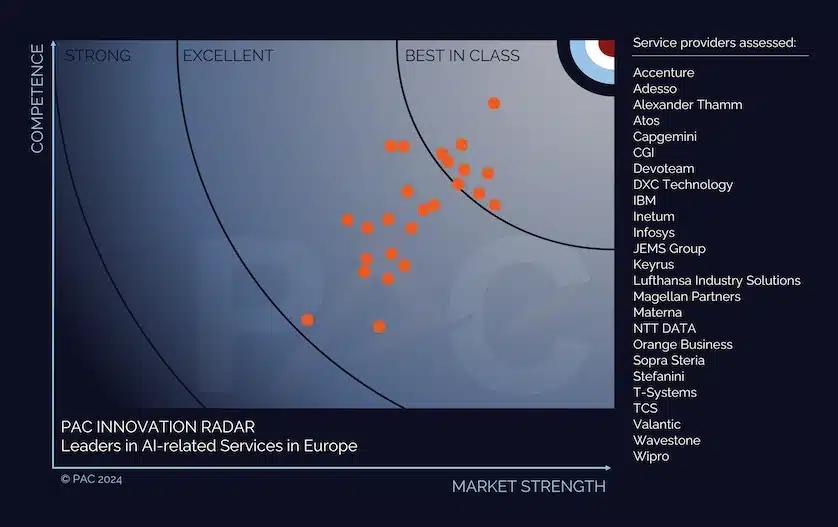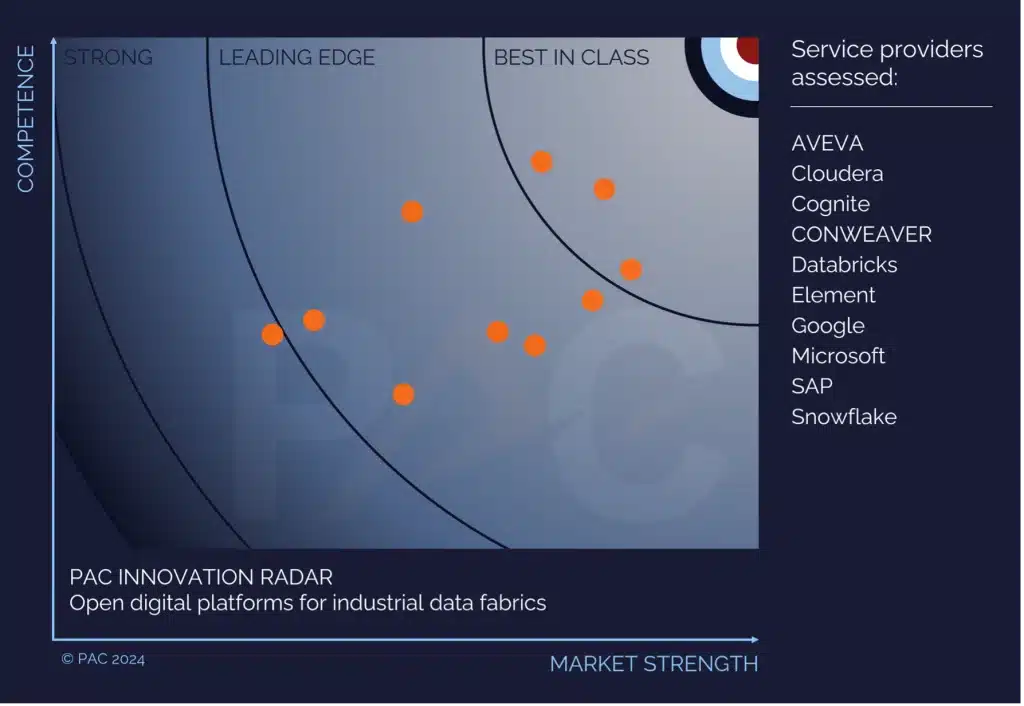IT Trends in 2024:
5 Predictions ranging from hyper-personalisation to AI inbreeding
- PAC, the leading European consulting and analyst firm for the IT industry, has compiled the key 2024 trends for IT leaders.
- As well as stricter cloud cost management, factors such as effective security management will play a key part in the future.
- At the same time, GenAI will enable organisations to finally achieve hyper-personalised customer experiences.
Munich, December 12, 2023 | PAC has made a name for itself as the leading European consulting and analyst firm for the IT industry. With a clear focus on the specific market trends in Europe, PAC experts cover more than 30 countries in depth. At the end of each year, the analysts from PAC publish their key predictions for the following year, based on detailed analysis. They highlight the main trends that will impact the IT market in different ways.
The analysts have picked five pivotal trends they predict will lead to above-average growth, efficiency gains, and more sustainability for organisations in 2024 and beyond. As expected, many of them are directly or indirectly linked to artificial intelligence.
FinOps for GenAI: Managing cloud costs in the age of AI is becoming a challenge for organisations.
2023 has been a tipping point for AI services because of the amount of focus generative AI (GenAI) has had. Organisations are at another FinOps inflection point as GenAI requires high levels of compute and data processing that are only affordable at scale delivered through a cloud service. PAC considers GenAI to be what the tech industry calls a “killer application” in that it is an innovation for which the use case impacts both the personal and professional lives of people at scale across the globe. At the same time, PAC considers there to be a significant level of risk to organisations where the demand for such services will drive increases in costs at a magnitude and pace far worse than was experienced during the initial cost issues of cloud sprawl that occurred. “Organisations therefore need to effectively manage cloud-service costs for AI across all business functions through FinOps, and create a culture of financial transparency and accountability”, advises Spencer Izard, Principal Analyst at PAC.
MLSecOps: Effective security management is critical as the use of “multi-hop” AI grows.
As AI usage increases, so does the need to adapt security practices to ML and DL-related workflows. Many organisations are facing the challenge of incorporating AI in a multitude of IT solutions to support their business models – all too commonly leading to increased risk exposure for organisations that have not adapted their cybersecurity strategy in parallel with their AI strategy. MLSecOps frameworks will evolve further to become critical to securing AI solutions and services. As organisations adjust their processes to leverage a wide range of AI services, the occurrence of multi-hop AI will grow rapidly and be a major challenge. PAC defines multi-hop AI as the chaining together of multiple AI solutions or services and their data sets into an integrated pipeline or supply chain, with each “hop” leveraging a different, often cloud-based, AI solution or service. This AI usage will span solutions and services from a wide range of IT suppliers. It will not have any human interaction between the intermediate “hops”, with humans providing the initial input and then receiving the multi-hop output. PAC considers this a revolutionary step, but also a risk, in using AI. “The added value of AI for organisations is offset by the potential for new forms of security breaches. From a cybersecurity perspective, data is the most valuable asset that malicious actors can acquire – and as it is at the heart of all AI, this is an area CxOs will need to focus on intensively in the coming years”, says Spencer Izard.
Addressing AI inbreeding: How the adoption of responsible and explainable AI can mitigate the risk.
As the evolution of AI has occurred, an issue with the technology that is critical to address has also increased in prominence: the concept of “AI inbreeding”. This phenomenon occurs when AIs are predominantly consuming content produced by other AIs,providing results not based on reality but a distorted perspective. Whilst the recent versions of the ChatGPT model, for instance, have been trained on a relatively clean range of predominantly human-generated data points, society will very rapidly be in a position where AIs are predominantly consuming content produced by other AIs that may vary over many processing iterations from relevance to human societal perspectives. This trend, which is particularly pronounced in generative AI (GenAI), may impact the long-term effectiveness of AI solutions. “PAC considers this a very serious warning sign for a potential future that could have severe effects on the benefit of AI both for organisations and society”, warns Spencer Izard. Responsible and explainable AI frameworks and tools are key instruments to addressing this problem through increased transparency.
Hyper-personalisation: Digital assistants leverage GenAI to provide highly personalised customer experiences.
For years, organisations operating B2C or D2C channels have aspired to provide digital experiences akin to a personal shopper, with highly specific personalisation. Generative AI provides new opportunities for hyper-personalisation aimed at developing a stickier and more long-term relationship with customers that increases engagement and loyalty as well as cross and up-sell opportunities. In the past, this type of hyper-personalised digital shopper was too costly due to a lack of data and scalability. Additionally, before GenAI, chatbot-style interfaces were not sophisticated enough to provide purchasing advice or steer akin to that of a traditional personal shopper. PAC predicts, from 2024 onwards, the incorporation of GenAI into digital experiences on employee devices to support in-person engagements and through similar experiences directly to a customer’s personal devices. “As a result, GenAI will democratize access to personal shopper-style digital assistant services for consumers, simplify the business buying cycle, and create new revenue opportunities”, predicts Spencer Izard.
New ESG regulations: The CSRD will tighten requirements for organisations to make their IT landscapes sustainable.
From 2024 onwards, the Corporate Sustainability Reporting Directive (CSRD) will regulate environmental reporting throughout the EU, stepping up international ESG efforts. PAC experts consider the coming into force of the CSRD as an accelerator of the shift towards more sustainability in business. In the past, organisations were mainly interested in sustainability because their customers would ask for it and it provided an opportunity to drive revenues. Now the topic has turned into an obligation that can cause legal, reputational, and commercial damage. “Organisations will increasingly look for partners that can help them implement the right software solutions and processes to efficiently track, gather, and analyse data related to ESG”, says PAC Analyst Mopia Kamdoum. At the same time, the comparability of the reports will push businesses to showcase that they are at least as sustainably driven as their direct competitors. In addition, the trend towards more sustainability will encourage organisations to adopt a cloud-first strategy. Organisations not only appreciate the possibility of migrating individual workloads to the cloud with reasonable effort and operating costs; increasingly, they will also ask how sustainable different cloud offerings are. When selecting a cloud provider, sustainability will be a key factor, alongside the availability of service provider resources and adequate features in the PaaS environment. Also, we expect cloud providers to make efficiency parameters available to prospects to show how sustainable their offerings are.
Find out more about these and other PAC predictions in our more detailed blog post: https://sitsi.pacanalyst.com/pacs-predictions-for-2024/
About PAC
PAC is the leading European consulting and analyst firm for the IT industry, a content-based company with a consulting DNA. We accompany software & IT service vendors worldwide on their growth journey. Since 1976, we have helped our clients to understand market dynamics, grow their revenue, and raise their profile. PAC is an analyst-led consultancy with a team of over 100 experts across Europe. We provide market research and analysis on more than 30 countries worldwide, delivered through our portfolio pillars, Guidance, Insights, and Visibility, and our renowned SITSI® research platform.









